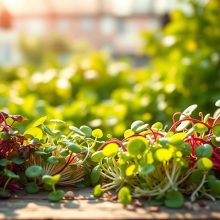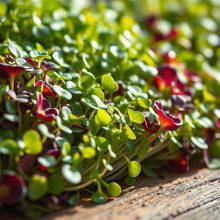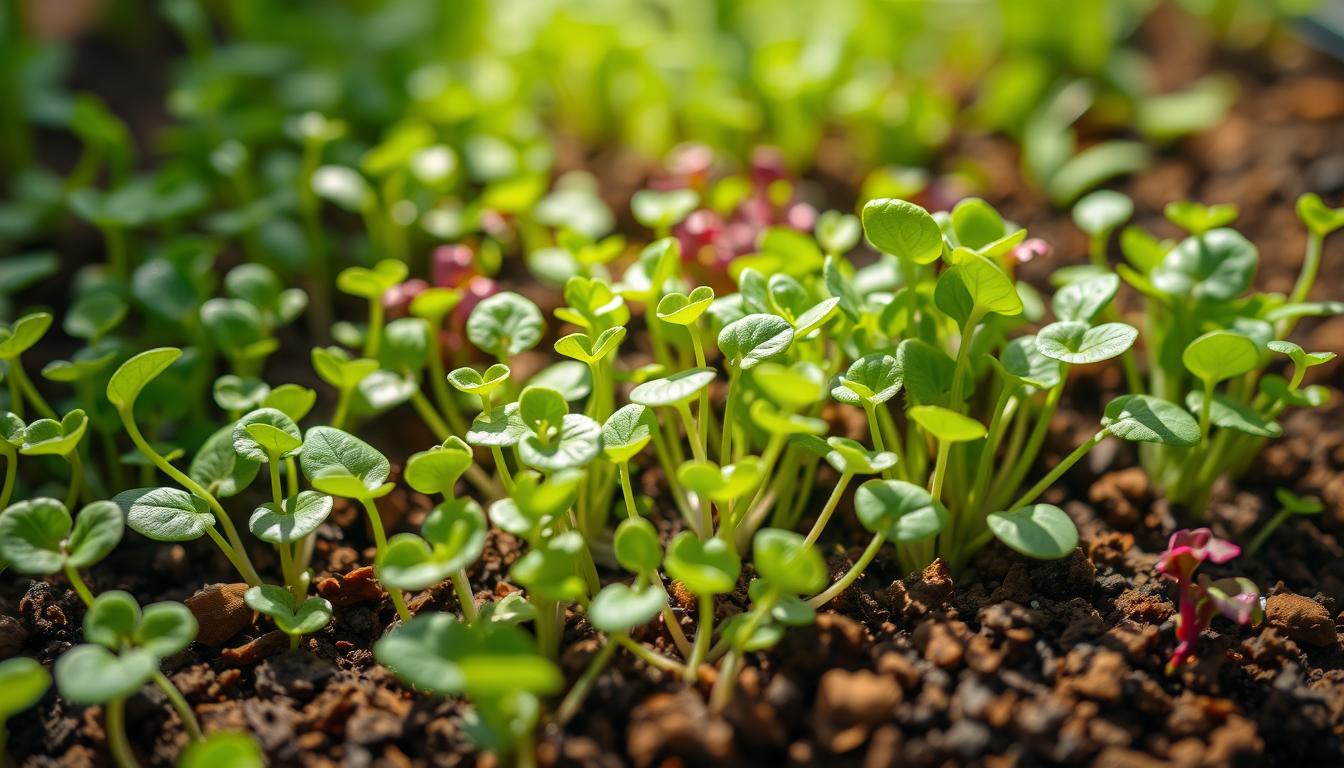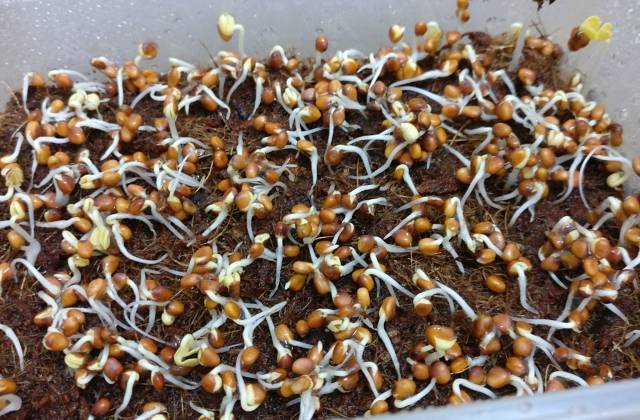Microgreens: Nutrient-Dense Powerhouses for Your Kitchen
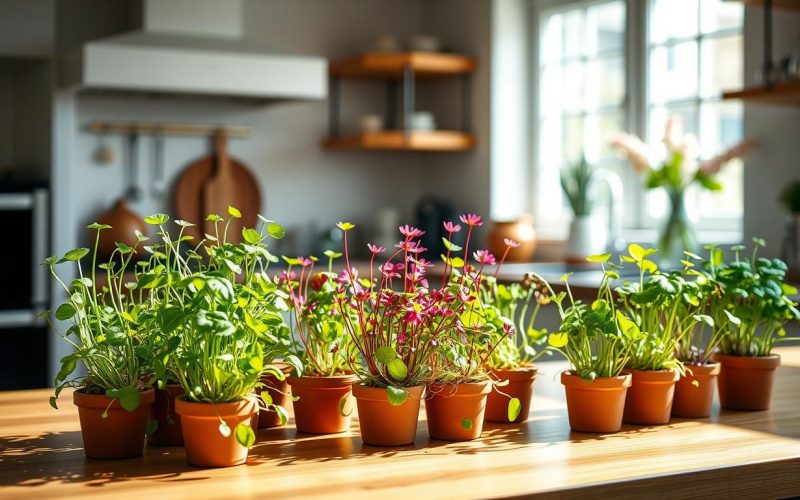
Explore the amazing world of microgreens, tiny greens that are super nutritious. These small plants are picked just a few days after they start growing. They have strong flavors and health benefits that chefs and home cooks love.
Microgreens are changing how we think about food and cooking. They grow from special seeds, needing little space and resources. They are full of nutrients, making simple meals into healthy, tasty dishes.
In kitchens everywhere, microgreens are making a big difference. They are easy to use and full of good stuff. Add them to salads, sandwiches, smoothies, and more for a nutritional boost.
Key Takeaways
- Microgreens are young vegetable greens harvested early in their growth cycle
- They contain higher nutrient concentrations compared to mature plants
- Easy to grow at home with minimal equipment
- Available in numerous varieties with unique flavor profiles
- Excellent source of vitamins, minerals, and antioxidants
What Are Microgreens?
Microgreens are tiny, vibrant plants harvested early, usually between 1-3 weeks after they start growing. They are packed with nutrients, offering intense flavors and bright colors. These small greens can turn simple dishes into culinary masterpieces.
Unlike regular vegetables, microgreens are young seedlings. They are at their most nutrient-dense stage. Chefs and health enthusiasts love them for their strong flavors and high nutritional value.
Common Varieties of Microgreens
Several microgreens stand out for their unique traits:
- Radish microgreens: Spicy and crisp
- Arugula microgreens: Peppery and bold
- Broccoli microgreens: Mild and slightly sweet
- Sunflower microgreens: Nutty and crisp
- Pea shoot microgreens: Fresh and tender
Distinguishing Microgreens from Sprouts
Many confuse microgreens with sprouts. But they are different. Microgreens grow in soil, develop leaves, and are harvested above the soil. Sprouts, on the other hand, are germinated seeds eaten root, seed, and shoot, grown in water without soil.
For home gardeners, growing microgreens is a rewarding experience. It requires minimal space and equipment. Anyone can grow their own fresh, flavorful microgreens at home.
Nutritional Benefits of Microgreens
Microgreens are tiny, but they are nutritional powerhouses. They offer a lot of health benefits in small leaves. These tiny veggies are more than just a garnish. They are a concentrated source of nutrients that can change your diet.
The health benefits of microgreens go beyond their small size. Research shows they have much more nutrients than full-grown veggies.
Vitamin and Mineral Content
Microgreens are packed with essential nutrients in a small package:
- Up to 40 times more nutrients than mature plant counterparts
- Rich in vitamins A, C, E, and K
- Excellent source of critical minerals like iron and magnesium
Antioxidant Powerhouse
These tiny greens are great at fighting cellular damage. They have high antioxidant levels. This helps protect the body from chronic inflammation and oxidative stress, which are linked to many health issues.
Key Health Benefits
Regularly eating microgreens supports many health areas:
- Boosts immune system function
- Reduces risk of heart disease
- Supports weight management
- Promotes cellular health
Adding microgreens to your diet is a simple way to boost your nutrition. It supports long-term health and wellness.
How to Grow Microgreens at Home
Growing microgreens at home is easy and rewarding. These small plants are full of nutrients and simple to grow in your kitchen. With basic supplies and patience, you can grow microgreens like a pro.
Selecting the Perfect Seeds
Choosing the right seeds is key for growing microgreens. Look for high-quality, organic seeds made for microgreens. Some top picks include:
- Radish seeds
- Sunflower seeds
- Broccoli seeds
- Arugula seeds
- Pea shoots
Essential Equipment for Microgreen Cultivation
To start growing microgreens, you need a few basic tools. Get these items ready for your microgreen journey:
- Shallow trays with drainage holes
- Organic potting soil or growing medium
- Spray bottle for watering
- Sharp scissors for harvesting
- Grow lights or sunny windowsill
Step-by-Step Growing Process
The growing process is simple. Start by filling a tray with soil, spreading seeds, and pressing them down. Mist the seeds with water and cover with a clear lid or plastic wrap. Keep it warm and moist.
In 3-7 days, your microgreens will sprout. Remove the cover and make sure they get enough light. Harvest when they’re 1-3 inches tall by cutting just above the soil line with clean scissors.
Culinary Uses of Microgreens
Microgreens are a game-changer in the kitchen. They turn simple meals into amazing dishes with their bright flavors and lots of nutrients. These small greens add a big boost to any recipe, making cooking more exciting.
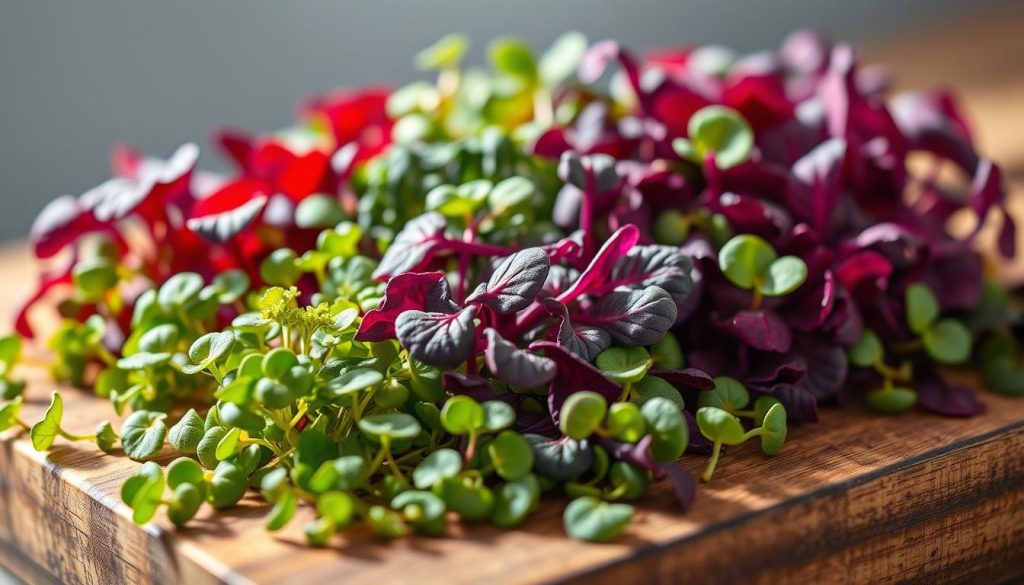
Chefs and food lovers love microgreens for their unique taste and texture. They add depth and complexity to many dishes. Their soft texture and strong flavors make them great for many uses in the kitchen.
Adding Flavor and Texture
Microgreens bring amazing flavors to your food. They taste spicy, peppery, mild, or sweet, depending on the type. Some of their key benefits are:
- Intense, concentrated flavors
- Delicate, crisp textures
- They make dishes look good
- They add nutrients
Microgreens in Salads
Adding microgreens to salads makes them gourmet. These small greens can turn a simple salad into a fancy dish. Mix different microgreens for unique flavors in your recipes.
Garnishing Dishes
Microgreens are perfect as fancy garnishes. Sprinkle them on soups, proteins, or pasta for a fresh look. They not only make dishes look better but also add subtle, complex flavors.
Popular Microgreens to Try
Microgreens are a hit with home gardeners and chefs. They are small but packed with nutrients. They add flavor and nutrition to your food.
Choosing the right microgreens can change your cooking and health. Here are some top picks for growing and buying:
Arugula Microgreens
- Peppery and bold flavor profile
- Rich in vitamins A, C, and K
- Excellent for salads and garnishing
Radish Microgreens
- Spicy and tangy taste
- Packed with vitamins and minerals
- Contains powerful antioxidants like anthocyanins
Basil Microgreens
- Intense aromatic flavor
- Great for Italian and Mediterranean dishes
- High in antioxidants and essential nutrients
Pea Shoots
- Sweet and delicate flavor
- Excellent source of protein
- Perfect for stir-fries and salads
These microgreens offer special nutritional benefits and cooking options. Whether you grow them yourself or buy them, they add vibrant flavors and nutrients to your meals.
Sustainable Growing Practices
Growing microgreens at home is a great way to practice sustainable farming. It lets you create a small, eco-friendly garden. This garden helps you eat well and keeps the environment healthy.
To start growing microgreens sustainably, you need to manage resources wisely. Make choices that are good for the planet.
Organic Growing Methods
Choosing organic seeds and soil is essential for growing microgreens the right way. Organic farming reduces harmful chemicals and keeps nature in balance.
- Use certified organic seeds from trusted sources
- Choose organic potting mix without synthetic fertilizers
- Avoid chemical pesticides and herbicides
Water Conservation Techniques
Watering microgreens wisely is important. Simple steps can cut down water use and keep plants healthy.
- Use bottom-watering methods
- Collect rainwater for watering
- Use shallow trays to save water
Soil Health Considerations
Healthy soil is vital for strong microgreen growth. It also helps your garden last longer. Change your growing mediums and add compost to boost nutrients.
- Rotate growing trays and mediums
- Add organic compost for nutrient replenishment
- Check soil pH and mineral levels
By using these green practices, you can grow microgreens in a way that’s good for the planet. It’s a responsible and eco-friendly way to garden at home.
Microgreens in the Marketplace
The world of microgreens has grown a lot, giving people many ways to buy them. You can choose to buy online or find them locally. Knowing the market helps you pick the best greens for your needs.
- Farmers markets
- Local grocery stores
- Specialty produce shops
- Online retailers
- Direct farm subscriptions
Where to Buy Fresh Microgreens
To get the best microgreens, you need to know where to look. Farmers markets are great for fresh greens, as growers sell directly to you. Stores like Whole Foods and local organic markets also carry a variety of microgreens.
Price Comparison
Microgreens cost between $20 and $50 per pound. This is more than regular greens. Prices go up because:
- Growing them is complex
- They’re very nutritious
- Producing them takes a lot of work
- They don’t last long
Local vs. Online Purchasing
Buying online has its own set of considerations. Shipping can add to the cost, and greens might not stay fresh as long. Buying locally means you get them right away but might not find as many types.
Smart shoppers can mix both ways. Use local places for everyday needs and online for special types you can’t find nearby.
Incorporating Microgreens into Your Diet
Microgreens are tiny plants that are full of flavor and health benefits. They can make any meal special. Adding them to your food can make it more nutritious and colorful.
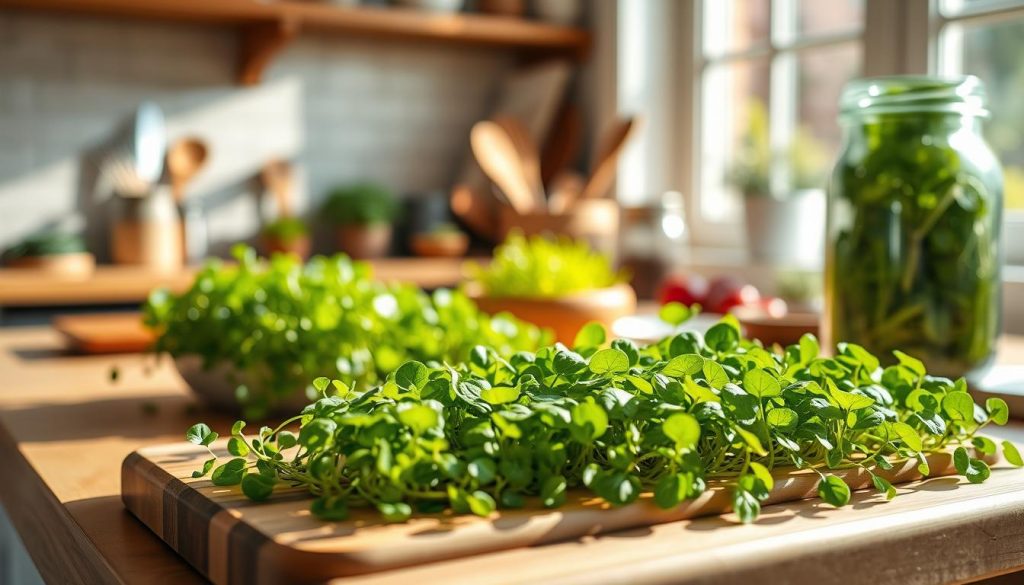
Adding microgreens to your diet is easy. Here are some fun ways to use them:
- Sprinkle on top of breakfast omelets for an extra nutrient boost
- Blend into smoothies for enhanced health benefits of microgreens
- Use as a fresh garnish for soups and salads
- Add to sandwiches and wraps for a crisp texture
Creative Recipe Ideas
Microgreens can make simple dishes taste amazing. Try mixing radish, arugula, and basil microgreens for a unique flavor. A simple pasta dish can become special with a topping of fresh microgreens.
Pairing Microgreens with Proteins
Microgreens can make protein dishes more exciting. A light microgreen salad on top of grilled chicken or fish is a great idea. It adds flavor and nutrients without overpowering the protein.
Smoothies and Juices Enhancement
Make your morning smoothie better with microgreens. Kale or broccoli microgreens blend well with fruit, adding extra nutrition. Start with a little and add more to find the right mix.
The Science Behind Microgreens
Microgreens are a blend of nutrition and plant science. They are tiny but pack a big nutritional punch. This is why they are so fascinating to researchers and health fans.
The way microgreens grow is complex. It affects how much nutrition they have. Young plants have lots of vitamins, minerals, and antioxidants.
Growth and Development Dynamics
Microgreens grow fast, from seed to ready-to-eat in just 7-14 days. They get nutrients quickly, unlike bigger plants. This fast growth is key to their nutritional benefits.
- Rapid nutrient accumulation
- Concentrated vitamin and mineral content
- Enhanced metabolic efficiency
Environmental Influences on Nutrition
Light and soil quality are crucial for microgreens. The right growing conditions boost their nutrition. Farmers use controlled environments to make these greens as nutritious as possible.
Nutrient Density Comparisons
Studies show microgreens have up to 40 times more nutrients than full-grown plants. They are a great way to get lots of nutrition in small amounts. This makes them perfect for a healthy diet.
- Higher nutrient concentration
- Increased antioxidant levels
- Compact nutritional profile
Fun Facts About Microgreens
Microgreens have caught the eye of food lovers and scientists. These small plants are packed with nutrients. They are found in fancy restaurants and home gardens, exciting both researchers and food enthusiasts in the U.S.
Chefs in San Francisco made microgreens popular in the 1980s. They turned these small greens into a gourmet favorite. Experts suggest starting with radish, sunflower, and broccoli for their strong flavors and easy growth.
Research shows microgreens are incredibly nutritious. The University of Maryland found they have up to 40 times more nutrients than full-grown plants. This makes them perfect for growing in small spaces, ideal for city gardens.
Microgreens have also become a part of popular culture. They appear in cooking shows and health documentaries. Their nutritional value and versatility inspire chefs and home cooks to try these tiny greens.
FAQ
What exactly are microgreens?
Are microgreens really more nutritious than mature vegetables?
How difficult is it to grow microgreens at home?
Which microgreens are the easiest to grow for beginners?
How should I store fresh microgreens?
What are the best ways to use microgreens in cooking?
Are microgreens organic and sustainable?
Where can I buy high-quality microgreens?
How do microgreens differ from sprouts?
What is the cost of growing microgreens compared to buying them?
FAQ
What exactly are microgreens?
Microgreens are young greens harvested just after the first true leaves appear. This happens 7-14 days after they start growing. They are smaller than baby greens but larger than sprouts. They are packed with nutrients and have strong flavors, making them popular among chefs and health enthusiasts.
Are microgreens really more nutritious than mature vegetables?
Yes, research shows microgreens can have up to 40 times more nutrients than mature veggies. They are full of vitamins C, E, and K, and carotenoids. This makes them a great addition to a healthy diet.
How difficult is it to grow microgreens at home?
Growing microgreens at home is easy and needs little equipment. You’ll need a shallow tray, organic seeds, potting soil, and indirect sunlight. Most varieties can grow indoors all year with little gardening knowledge.
Which microgreens are the easiest to grow for beginners?
Radish, sunflower, and pea shoot microgreens are great for beginners. They grow fast, are easy to care for, and taste great. They’re ready to harvest in 7-10 days.
How should I store fresh microgreens?
Keep microgreens in a sealed container in the fridge. Use a damp paper towel to keep them moist. They stay fresh for 5-7 days. Don’t wash them before storing to prevent them from getting soggy.
What are the best ways to use microgreens in cooking?
Microgreens are versatile and can be used in many ways. Use them as garnishes, in salads, sandwiches, and smoothies. They also make great toppings for soups and pizzas. They add flavor and nutrition to any dish.
Are microgreens organic and sustainable?
Many growers use organic methods for microgreens. They use non-GMO seeds, organic soil, and little water. This makes them a sustainable choice that uses less space and water than traditional farming.
Where can I buy high-quality microgreens?
You can find microgreens at farmers’ markets, specialty stores, health food stores, and online. Some local farms and urban projects also offer microgreen subscriptions.
How do microgreens differ from sprouts?
Microgreens are grown in soil and harvested just above the soil. Sprouts are germinated in water and eaten whole. Microgreens have true leaves and more nutrients and flavor than sprouts.
What is the cost of growing microgreens compared to buying them?
Growing microgreens at home is cheaper than buying them. A small investment in seeds and trays can give you many harvests. Some varieties cost just
FAQ
What exactly are microgreens?
Microgreens are young greens harvested just after the first true leaves appear. This happens 7-14 days after they start growing. They are smaller than baby greens but larger than sprouts. They are packed with nutrients and have strong flavors, making them popular among chefs and health enthusiasts.
Are microgreens really more nutritious than mature vegetables?
Yes, research shows microgreens can have up to 40 times more nutrients than mature veggies. They are full of vitamins C, E, and K, and carotenoids. This makes them a great addition to a healthy diet.
How difficult is it to grow microgreens at home?
Growing microgreens at home is easy and needs little equipment. You’ll need a shallow tray, organic seeds, potting soil, and indirect sunlight. Most varieties can grow indoors all year with little gardening knowledge.
Which microgreens are the easiest to grow for beginners?
Radish, sunflower, and pea shoot microgreens are great for beginners. They grow fast, are easy to care for, and taste great. They’re ready to harvest in 7-10 days.
How should I store fresh microgreens?
Keep microgreens in a sealed container in the fridge. Use a damp paper towel to keep them moist. They stay fresh for 5-7 days. Don’t wash them before storing to prevent them from getting soggy.
What are the best ways to use microgreens in cooking?
Microgreens are versatile and can be used in many ways. Use them as garnishes, in salads, sandwiches, and smoothies. They also make great toppings for soups and pizzas. They add flavor and nutrition to any dish.
Are microgreens organic and sustainable?
Many growers use organic methods for microgreens. They use non-GMO seeds, organic soil, and little water. This makes them a sustainable choice that uses less space and water than traditional farming.
Where can I buy high-quality microgreens?
You can find microgreens at farmers’ markets, specialty stores, health food stores, and online. Some local farms and urban projects also offer microgreen subscriptions.
How do microgreens differ from sprouts?
Microgreens are grown in soil and harvested just above the soil. Sprouts are germinated in water and eaten whole. Microgreens have true leaves and more nutrients and flavor than sprouts.
What is the cost of growing microgreens compared to buying them?
Growing microgreens at home is cheaper than buying them. A small investment in seeds and trays can give you many harvests. Some varieties cost just $1-2 per tray, compared to $3-5 for store-bought.
-2 per tray, compared to -5 for store-bought.
